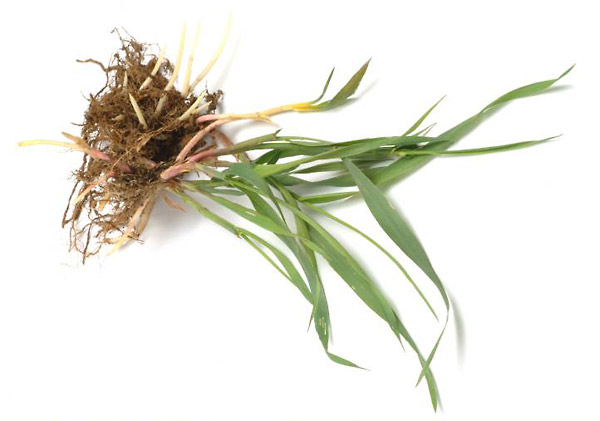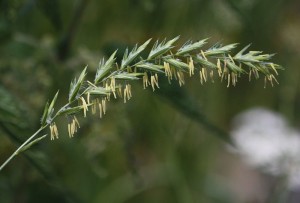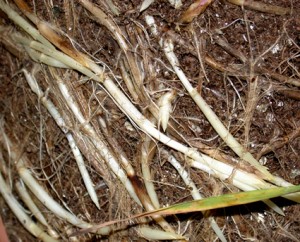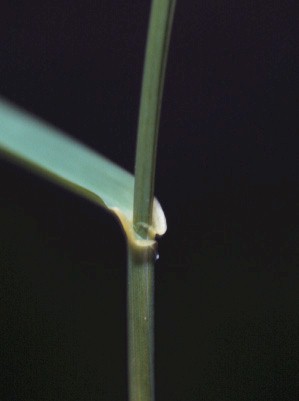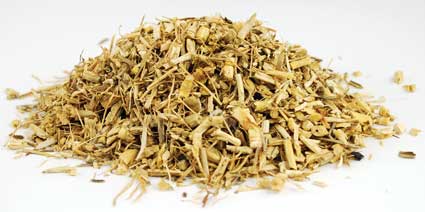Plants of little use often have only one common name, or not even that. Plants that are valued or are a pest usually have too many names such Quack Grass.
Most people today know Quack Grass, Elymus repens, as a pest, a hard-to-get-rid of weed found in corn and soybean crops, persistent and resistant to a variety of herbicides. To the Internet population Quack Grass is an herbal medicinal employed as a diuretic. Forgotten between reduced agricultural cash flow and increased urinary flow is Quack Grass as food.
In Edible Wild Plants of Eastern North America, Merritt Fernald, the grand botanical man of his day, wrote: The ubiquitous Quack-Grass or Witch-Grass (with scores of other colloquial names) is usually known merely as a persistent and obnoxious weed, most difficult to eradicate and completely eating up the good of the land; but it was shown in the 18th century that it might be eaten if one cared to utilize it. Thus the British botanist, Withering, wrote: ‘the roots dried and ground to meal have been used to make bread in years of scarcity.'”
Flour from the roots, not exactly what one might expect to learn. Daniel Moerman in his Native American Food Plants mentions seven species used as grain by the natives including E. repens. Also listed were: Elymus canadensis var. candensis, Elymus elymoides, Elymus glaucus, Elymus glaucus ssp. glaucus, Elymus multisetus, and Elymus sibiricus. Dr. Couplan in his Encyclopedia of Edible Plants of North America adds Elymus condensatus, Elymus triticoides, and Elymus canadensis (without the variation.) In Cornucopia II E. canadensis is reported as an important food for the Paiute. It also reports E. triticoides were parched and ground into a fine meal called pinole. It was eaten as porridge or in cakes and drinks. The book also warns that hair on the grain must be singed off before it is used as food. Quack Grass is not a large producer of grain, perhaps only 25 seeds per plant. The starchy root is more attractive from a foraging point of view.
Also called Couch Grass, Quitch, Twitch, Witchgrass and a couple of dozen other common names, it came to North America from Europe around 1818. Botanically, as one might expect, it has has several names: Agropyon repens, Elytrigia repens, Elytrigia vaillantiana, Triticul repens, Triticum vaillantianum, and most recently Elymus repens (EL-ih-mus REP-inns) which understandably translated means Low Growing Wild Millet. Elymus is Dead Latin’s version of an old Greek word for Millet (Elymos) which comes from Elgo which means to cover referring to the lemma and palea which tightly cover the seed. In botanical English it is often referred to as Wild Rye. In Greek mythology Elymus is also the natural son of Anchises and brother of Eryx; one of the Trojans who fled from Troy to Sicily. With the help of Aeneas they built the cities of Aegesta and Elymé. The Trojans who settled in that part of Sicily called themselves Elymi, after Elymus. He was also a man from Lemnos killed by Gorge when the women there killed all the males on the island. I know a family from Lemnos. So the he’s and she’s must have patched things up since then.
Quack Grass seed is some 12% oil and has 3 to 8% triticin, which is related to inulin which might make it suitable for diabetic use. On digestion triticin releases fructose; mucilage (10%); saponins; sugar alcohols (mannitol, inositol, 2% to 3%); essential oil with polyacetylenes or carvone (0.01% to 0.05%); small amounts of vanilloside (vanillin monoglucoside), vanillin, and phenolcarboxylic acids; silicic acid; and silicates.
Green Deane’s “Itemized” Plant Profile: Quack Grass
IDENTIFICATION: Elymus repens: A perennial grass from rhizomes reaching 3 1/2 feet in height. Leaves, 1 1/2 to 12 inches long, very skinny, under 1/2 inch. Blue green leaves may or may not have hairs on the upper surfaces, lower leaf hairless. Short membranous ligule, narrow auricles that clasp the sheath, the quickest and easiest element of identification. Seed head a long, narrow spike with many individual spikelets arranged in two rows along the stem. Spikes 2 to 8 inches long, seeds with awns. To separate it from other grasses look for the auricles, rhizomes, and a long, narrow spike for a seed head.
TIME OF YEAR: Can flower spring to fall.
ENVIRONMENT: Crop fields, turfgrass, lawns, nurseries, moist meadows, urban landscapes, disturbed areas.
METHOD OF PREPARATION: Grain winnowed, singed, used for flour porridge. Roots dried and ground, used like flour.

